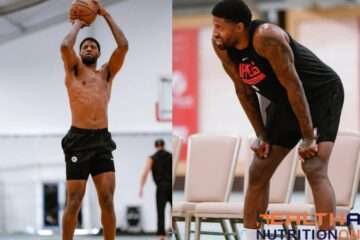How much does a bench press bar weigh? 5 Types You Need To Choose From.

The bars used for a bench press vary in weight, depending on the gym you’re training and the type of grip. However, the standard bench press bar weighs about 20kg on its own. Hence, even if you don’t load plates on a bench press bar, you are still carrying considerable weight.
What is the bench press?

The bench press is a basic weight training exercise that involves all the muscles in the upper body including the pecs, triceps, shoulders, and back. It is undoubtedly one of the most popular exercises in strength sports. Every gym is full of athletes who perform exercises for the pecs.
As one of the primary core exercises, the bench press stimulates the entire torso and is ideal for weight training and grip strength (hand strength) when performed correctly.
Bench press bars and their weights
The bar on which you can load plates to perform a press is called a bench press bar. Here are bars used for pressing on a bench:
1. Standard bar
You will find a standard bar on the bench press racks of most gyms. Standard bars are made of steel and have a slightly thicker diameter – compared to weight-lifting hooks – thus preventing any bending, even with the heaviest plates at each end. The diameter also makes it more comfortable for the average grip.
These bars typically weigh 20kg as stated earlier, but some with particularly thick handles weigh about 25kg. They are typically 7 feet long and can support at least 270kg weight – some are even strong enough to support up to 540kg weight.
A standard bar is the most ideal for a bench press because it has less whip.
2. Olympic Bar
Olympic bars are specially designed for those who train in weightlifting – the Olympic sport. Although they also weigh 20kg, like a standard bar, they are made of steel specially designed for the nature of the event, which involves the dynamic movements of the snatch and clean & jerk. They have a little more bend or whip to the steel so that they bounce and bend smoothly.
Although not designed for bench pressing, you may find one on a bench press rack. Even though most gym facilities use the standard bar, coaches and fitness staff may incorrectly refer to bars on a bench rack as “Olympic bars.”
3. Cardio Barbell Equipment
If you’re working out on the bench press rack in a group weight training class, chances are your bar is quite different from the ones you’ll find on the gym floor. The cardio barbell is typically made of carbon, a material that’s lighter than steel, and weighs around 5 pounds, including the clamps that hold the plates in place.
This equipment is designed for high representativeness lifts, rather than maximum lift like the bars you’ll find on the gym floor. At maximum, the bar could weigh around 45kg which would be very heavy for these classes.
4. Swiss bar
The Swiss bar looks like a standard bar with a rectangular center. Inside the rectangle, bars serve as additional gripping options – straight or angled. This bar allows you to easily change grip or add weight in unconventional ways – for example with chains – to add variety to your bench workout. The bar weighs less than a standard or Olympic bar – weighing about 16kg.
5. EZ Curl Bar

You are more likely to find the EZ curl bar on a stand or a preacher’s chair. They allow for a more biomechanically neutral grip for bicep curls, but it’s not uncommon to see someone squeeze with one – especially if you’re looking for a lighter lift. An EZ bar for bench press might seem a bit awkward, but it will do. They weigh about 7kg before adding plates.
What muscles are used in a bench press?
-
The pectoralis major muscle and pectoralis minor muscle
These muscles play a central role during the bench press. The pectoralis minor pulls the scapula towards the chest wall while the pectoralis major pulls the arms towards the body.
-
The deltoid muscle
This is one of the muscles in your shoulders and will help you lift the bench press bar in the air.
-
The triceps brachii muscle
This is located at the back of the arms. The triceps are active during the bench press and allow you to straighten the arms.
-
The auxiliary muscles
The auxiliary muscles used during the bench press are:
- The latissimus dorsi muscle: a muscle of the shoulder and trunk which also acts on the thoracic part. It allows you to bring down the arms and straighten the chest.
- The trapezius and rhomboid muscles: bring the shoulder blades together.
- Forearm muscles: grip strength comes from your hand and forearm muscles. They help stabilize you when you lift the bench press bar.
Bench press: how to do the right exercise?
-
Start by lying on a bench press correctly
Ensure that your shoulders are positioned slightly backward and your back forms a slight hollow. The line from your shoulders to the lumbar spine should rest on the bench. It must be possible to pass an arm under your back, precisely at the level of the erector muscles of your spine.
Allow your head to rest flat on the bench and fix your eyes on the bar. Let your feet rest on the ground, and your legs are at a 90 ° angle.
-
Grasp the bar with a shoulder-like spread
Ensure that your wrists are kept straight and your hands grip the bars with a firm grip.
-
The movement can now begin
Breathe in deeply and contract your back, buttocks and keep your shoulder blades together. By inhaling deeply, you stabilize the central part of the body and relieve your intervertebral discs as well as your spine from the load exerted.
-
The bar is now deposited slowly and in full control on your chest.
Your chest remains under constant tension. The brief stop on your chest should not give rise to a release of tension. The lower limit of the sternum (below the nipples) serves as a landmark for arrest.
For a good execution, it is then a question of pushing the bar explosively upwards. While doing this, it is essential to tighten the shoulder blades and keep the central part of your body firm and stable. Your strength is enhanced by the exhalation coming from the abdomen and the stable position of the feet.
Bench press: common mistakes to avoid
- Poor breathing or no breathing (breathing through the abdomen is important to stabilize the central part of the body).
- Grip too spaced / narrow (the load becomes too heavy for the triceps or the shoulder, and it is no longer the pectoral muscle that is used).
- Elbows too far from the body (more than 45 °) – the load on the shoulder joint is too great. This induces a high risk of injury.
Why is the back hollow during the bench press?
Your spine is naturally S-shaped whether you’re standing or lying on a weight bench. This is why a slight hollow of the back during the exercise of the bench press is not a mistake. It allows you to bring more tension to your body and to improve the biomechanical movement.
Note: during the bench press, your shoulders and buttocks must always be in good contact with the bench and support, despite a natural curvature of the back. Your feet are also anchored to the ground
Bench press variants
A simple modification of the grip can accentuate the training of the pectorals. For example, if you take the bench press bars with your hands closer together, you will put more strain on the muscles of the central part of your chest and the triceps But spreading your hands while doing the exercise will target the outer parts of the muscles of your chest.
For athletes who suffer from back pain, you can do a bench press variant with the legs raised. This prevents an arch from forming and the back from undergoing more pressure.
The bench press is an exercise that is normally done with a barbell bar, but the use of dumbbells or even kettlebells can diversify the workout. The bench press with dumbbells requires mastery of coordination. One of the advantages of this variation is that the weight is more uniform on each arm and allows a better range of motion. You thus work a little more the central part of the pectorals.
Another variation is the incline bench press. It consists of increasing the tilt angle of the weightlifting bench from 30 to 45 ° while performing the exercise. The exercise is then done in an upright position. The height of the shoulder is slightly above the pelvis. Thus the stimulus acts more on the upper part of the pectorals than on the musculature of the shoulder.
It is also possible to perform the exercise by tilting the bench slightly downwards: this exercise is called the declined bench press. It allows working the lower part of the pectorals.
Performing the bench press: our tips & tricks

It is important to warm up the shoulder girdle (rotator cuff, tendons, and ligaments) to prevent injuries and for better mobility. We recommend that you perform warm-up sets before the planned exercise sets to gently get closer to the weight planned for your bench press.
Also, keep your head and chin aligned with your neck. Ensure that your head is resting on the bench the entire time of the exercise (this reduces the risk of spinal injury).
Ensure that your feet and heels are well anchored in the ground for better stability
Plan your first sessions with a friend or someone who is already used to this exercise. It is not only more fun, but it also allows you to position yourself better from the start and to be assisted at the start to avoid any risk of injury.
Your gym partner can see your posture, improve it, or help you with the weights by standing behind you. Remember that technique always comes before performance.
Conclusion
Generally, the less the whip of a bar, the more suitable the bar is for a bench press exercise. The most suitable type of bar for a press(in terms of whip and weight), especially if you are a beginner, is the standard bar – which mostly weighs only 20kg.
Don’t Miss;
The 3 Best Exercise Mat For Sit-Ups
Hourglass Workout Routine And Diet Plan.








[…] You might also like; How much does a bench press bar weigh? […]